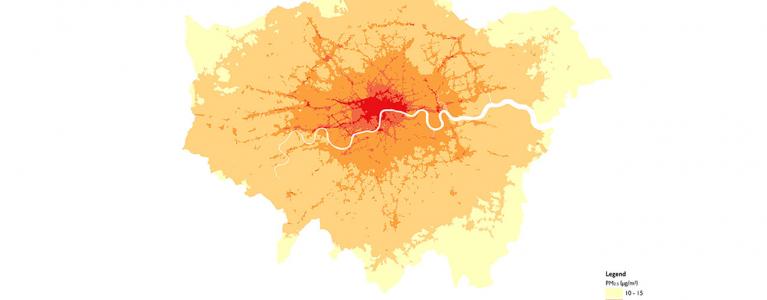
Air quality is dangerously poor in every London borough, with all 8.6 million people living in the capital exposed to toxic levels of pollution, a new map shows today.
More than nine in ten Londoners live in areas where superfine PM2.5 particles exceed World Health Organization guidelines by more than 50 percent.
Superfine PM2.5 particles are those most damaging to health, causing 29,000 premature deaths in the UK each year. Even short-term exposure raises the likelihood of heart and respiratory diseases, while children exposed to the particles are more likely to suffer reduced lung function and asthma.
In central London, the annual PM2.5 average is almost double the WHO health limit of 10 micrograms per cubic metre of air, according to London Atmospheric Emissions Inventory data.
Releasing the report at the Every Journey, Every Child conference at City Hall, Mayor Sadiq Khan said the findings were “another damning indictment of the toxic air that all Londoners are forced to breathe every day.”
“We should be ashamed that our young people – the next generation of Londoners – are being exposed to these tiny particles of toxic dust that are seriously damaging their lungs and shortening their life expectancy,” he said.
The Mayor on Wednesday signed London up to the BreatheLife coalition of world cities working together to improve air quality, an initiative of the WHO, UN Environment and the Climate and Clean Air Coalition.
A new toxicity charge (T-Charge) comes into force on 23 October to remove older, more polluting vehicles from central London, while plans for an Ultra Low Emission Zone have been brought forward to 2019.
Road transport is responsible for around half of emissions of nitrogen dioxide - a polluting gas – in the capital, with most of these caused by diesel vehicles.
The Mayor is also calling on the Government for greater powers to tackle air pollution from sources other than road transport, such as river boats and construction machinery.
“London’s plan to clean up their air means millions of people will be able to walk to work and walk their children to school without worrying about whether the air is going to make them sick,” Dr Tedros Adhanom Ghebreyesus, Director-General of the World Health Organization, said.